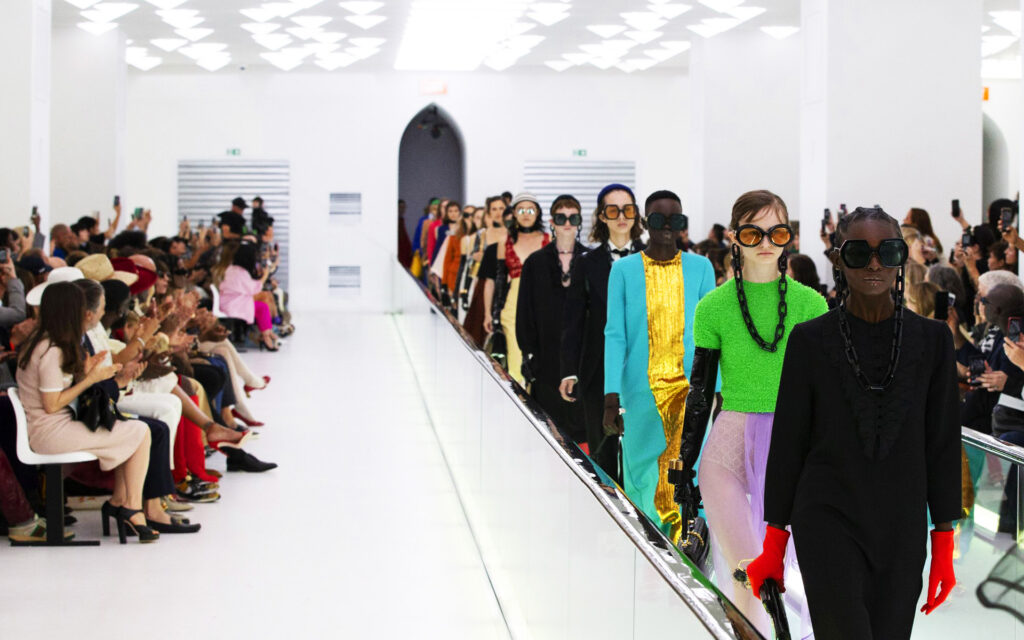September is an important month in the fashion industry. It is when the fashion weeks take place in New York, London, Milan, and Paris. It is where the most relevant designers present their collections in fashion shows that set the trends that will be worn in the coming seasons.
As a general idea, the fashion calendar is composed of four main seasons: Fall/Winter and Spring/Summer, with women’s and men’s collections.
The Fall/Winter collections occur in February/March, and the Spring/Summer collections in September. This means that each collection is presented 6 months in advance. That way there is enough time to complete production, ship to stores in advance of the next season, and for buyers to place their orders.
During the rest of the year, there are Prêt-à-Porter (Ready-to-wear), Haute Couture, Pre-Fall, Cruise or Resort fashion shows.
In addition to the main fashion weeks, the runways of Berlin, Copenhagen, Los Angeles, Madrid, São Paulo, Seoul, and Tokyo, among many others, are worth mentioning.
And because of the numerous fashion shows, there has been a growing worldwide concern about the high environmental impact that these presentations generate year after year.

Our travel footprint
According to Forbes magazine, the fashion industry is worth more than $2.5 trillion. On average, a 10 to 15-minute event can cost anywhere from $200,000 to over a million dollars.
The costs of a fashion show consists of location, producers, lighting, sound, public relations, invitations, models, stylists, hairdresser, makeup, and catering, among others.
According to Vogue Business, staging a runway show at Fashion Week in New York alone can cost anywhere from $125,000 to more than $300,000, excluding the price of samples. While costs can increase if the event is at a custom venue.
On the other hand, thousands of people from all over the world, including fashion magazine editors, press, experts, celebrities, influencers, and industry buyers, travel to different cities to attend events and shows.
To attend presentations, many attendees often fly in private jets.
According to Greenpeace, private flights cause 5 to 14 times more carbon emissions per passenger than the average commercial airliner and 50 times more than trains.
Consequently, the use of resources coupled with flying is generating a huge environmental footprint.

Zero to Market Report
A report published by fashion technology company ORDRE in collaboration with consultancy Carbon Trust, calculated the travel costs associated with fashion weeks as of the spring 2018 season.
The four main fashion weeks were evaluated during four women’s and two men’s seasons, as well as attendance and participation in runway shows in Copenhagen, Tokyo, and Seoul.
This study collected data from 5,096 designers along with 2,697 shoppers such as Galeries Lafayette, Net-a-Porter, and Selfridges, to calculate the carbon emissions produced over a 12-month period.
The research revealed that in a single year, the Spring/Summer 2018 Prêt-à-porter season, generated a total of 241,000 tons of carbon emissions into the atmosphere from air travel, accommodation, intercity travel, and transport of garments.
New York Fashion Week was the biggest carbon culprit with 37% of all emissions. It was followed by Paris with 28%, London with 18%, and Milan with 17%.
According to the report, these are conservative estimates as the research focused on travel emissions associated with the commercial aspects and collections of fashion weeks, without taking into account media and guests.
While the emissions measured in this study are likely to represent a small percentage of the total emissions of the fashion sector, it is a highly visible part of the sector where positive change can influence the entire supply chain and other sectors
Pauline Op de Beeck from Carbon Trust.

The report also included suggestions on how to solve the problem. Combining the men’s and women’s seasons in the same show or combining the pre-fall and fall collections were some suggestions.
Sustainable fashion show
Many companies committed to fighting the climate crisis are working together to minimize their carbon footprint.
Diesel and Marni are upcycling to reduce their environmental impact. The international production company Bureau Betak, in charge of major fashion shows, has become part of the ISO 20121 standard.
Gabriela Hearst
The Uruguayan designer’s Spring-Summer 2020 runway show was the first show with a zero carbon footprint. Together with EcoAct and Bureau Betak, they examined the necessary aspects of the production, design, and installation process. The idea was to minimize the resulting carbon footprint and thus determine the consequent compensation amounts.
Gucci
The Italian firm presented a carbon-neutral runway show during Milan Fashion Week 2020. They committed to offsetting emissions from guest and employee travel, using recycled wood for the decor and Forest Stewardship Council-certified paper for invitations.
Burberry
Luxury fashion house Burberry’s Autumn/Winter 2020 show was also carbon-neutral. It took place in a certified sustainable location, prioritized electric vehicles, and did not use air transport. The brand collaborated with the PUR Project to plant trees and help restore native ecosystems damaged by forest fires on behalf of guests.
Stella McCartney
The English designer’s firm says it is mindful of the impact of its runway shows and events, where it serves vegan food backstage and uses digital rather than physical invitations.
Copenhagen Fashion Week
Starting in 2020, Copenhagen Fashion Week introduced a minimum set of sustainability requirements to be met by all firms participating in its fashion shows.
The minimum standards cover six focus areas covering the entire value chain: 1) strategic directions, 2) design, 3) smart choice of materials, 4) working conditions, 5) consumer engagement, and 6) parade.

In order to meet the goals of the 2030 Agenda for Sustainable Development, the fashion industry must reduce greenhouse gas emissions and compensate for the carbon footprint created not only by fashion shows but by all events related to the sector.





